Adsorption–Desorption of Antimony (V) and Phosphorus (V) in Two Typical Soils: Release Behavior and Environmental Implications
Abstract
1. Introduction
2. Material and Methods
2.1. Soils
2.2. Batch Experiments
2.3. Models
2.4. Column Experiments
2.5. Sample Analysis
2.6. Data and Figure Processing
3. Results and Discussion
3.1. Effect of P(V) on Sb(V) Adsorption
3.2. Adsorption Isotherm
3.3. Kinetic Sorption-Desorption
3.4. Non-Equilibrium Transport
4. Conclusions
Author Contributions
Funding
Data Availability Statement
Conflicts of Interest
References
- Filella, M.; Belzile, N.; Chen, Y. Antimony in the environment: A review focused on natural waters I. Occurrence. Earth-Sci. Rev. 2002, 57, 125–176. [Google Scholar] [CrossRef]
- Wilson, S.; Lockwood, P.; Ashley, P.; Tighe, M. The chemistry and behaviour of antimony in the soil environment with comparisons to arsenic: A critical review. Environ. Pollut. 2010, 158, 1169–1181. [Google Scholar] [CrossRef] [PubMed]
- Tang, H.; Hassan, M.; Nawaz, M.; Yang, W.; Liu, Y.; Yang, B. A review on sources of soil antimony pollution and recent progress on remediation of antimony polluted soils. Ecotoxicol. Environ. Saf. 2023, 266, 115583. [Google Scholar] [CrossRef] [PubMed]
- Cai, Z.; Ren, B.; Xie, Q.; Deng, X.; Yin, W.; Chen, L. Potential toxic heavy metals in village topsoil of antimony mining area: Pollution and distribution, environmental safety—A case study of Qilijiang village in xikuangshan mining area, central Hunan Province, China. Ecol. Indic. 2023, 155, 111033. [Google Scholar] [CrossRef]
- Haider, F.; Zulfiqar, U.; Ain, N.; Mehmood, T.; Ali, U.; Ramos Aguila, L.; Li, Y.; Siddique, K.; Farooq, M. Managing antimony pollution: Insights into Soil–Plant system dynamics and remediation Strategies. Chemosphere 2024, 362, 142694. [Google Scholar] [CrossRef]
- He, M.; Wang, X.; Wu, F.; Fu, Z. Antimony pollution in China. Sci. Total Environ. 2012, 421–422, 41–50. [Google Scholar] [CrossRef]
- Bolan, N.; Kumar, M.; Singh, E.; Kumar, A.; Singh, L.; Kumar, S.; Siddique, K. Antimony contamination and its risk management in complex environmental settings: A review. Environ. Int. 2022, 158, 106908. [Google Scholar] [CrossRef]
- Lai, Z.; He, M.; Lin, C.; Ouyang, W.; Liu, X. Interactions of antimony with biomolecules and its effects on human health. Ecotoxicol. Environ. Saf. 2022, 233, 113317. [Google Scholar] [CrossRef]
- Okkenhaug, G.; Gebhardt, K.; Amstaetter, K.; Bue, H.; Herzel, H.; Mariussen, E.; Mulder, J. Antimony (Sb) and lead (Pb) in contaminated shooting range soils: Sb and Pb mobility and immobilization by iron based sorbents, a field study. J. Hazard. Mater. 2016, 307, 336–343. [Google Scholar] [CrossRef]
- Barker, A.; Mayhew, L.; Douglas, T.; Ilgen, A.; Trainor, T. Lead and antimony speciation associated with the weathering of bullets in a historic shooting range in Alaska. Chem. Geol. 2020, 553, 119797. [Google Scholar] [CrossRef]
- Kolbe, F.; Weiss, H.; Morgenstern, P.; Wennrich, R.; Lorenz, W.; Schurk, K.; Stanjek, H.; Daus, B. Sorption of aqueous antimony and arsenic species onto akaganeite. J. Colloid Interface Sci. 2011, 357, 460–465. [Google Scholar] [CrossRef]
- Qi, P.; Pichler, T. Competitive adsorption of As(III), As(V), Sb(III) and Sb(V) onto ferrihydrite in multi-component systems: Implications for mobility and distribution. J. Hazard. Mater. 2017, 330, 142–148. [Google Scholar] [CrossRef]
- Chen, W.; Deng, R.; Chen, Y.; Wang, C.; Hou, B.; Zhou, S.; Hursthouse, A. New insights into adsorption of As(V) and Sb(V) from aqueous by HCO–(Fe3O4)x adsorbent: Adsorption behaviors, competition and mechanisms. J. Water Process Eng. 2024, 58, 104873. [Google Scholar] [CrossRef]
- Gao, Y.; Mucci, A. Acid base reactions, phosphate and arsenate complexation, and their competitive adsorption at the surface of goethite in 0.7 M NaCl solution. Geochim. Cosmochim. Acta 2001, 65, 2361–2378. [Google Scholar] [CrossRef]
- Neupane, G.; Donahoe, R.; Arai, Y. Kinetics of competitive adsorption/desorption of arsenate and phosphate at the ferrihydrite–water interface. Chem. Geol. 2014, 368, 31–38. [Google Scholar] [CrossRef]
- Pintor, A.; Vieira, B.; Brandão, C.; Boaventura, R.; Botelho, C. Complexation mechanisms in arsenic and phosphorus adsorption onto iron-coated cork granulates. J. Environ. Chem. Eng. 2020, 8, 104184. [Google Scholar] [CrossRef]
- Wang, Q.; Zhang, G.; Liu, S.; Mao, K.; Ma, C.; Chen, J.; Liu, F. The impact of phosphate on the interaction of Sb(III) with ferrous sulfide. Appl. Geochem. 2022, 140, 105297. [Google Scholar] [CrossRef]
- Wang, Z.; Ma, X.; Pan, H.; Yang, X.; Zhang, X.; Lyu, Y.; Liao, W.; Shui, W.; Wu, J.; Xu, M.; et al. Investigating effects of phosphogypsum disposal practices on the environmental performance of phosphate fertilizer production using emergy analysis and carbon emission amounting: A case study from China. J. Clean. Prod. 2023, 409, 137248. [Google Scholar] [CrossRef]
- Tong, B.; Xu, H.; Liu, Z. Current global distribution of antimony mineral resources and suggestions for exploration and Investment in China. China Min. Mag. 2017, 26, 5–10. (In Chinese) [Google Scholar]
- Xie, Q.; Ren, B.; Shi, X.; Hursthouse, A. Factors on the distribution, migration, and leaching of potential toxic metals in the soil and risk assessment around the zinc smelter. Ecol. Indic. 2022, 144, 109502. [Google Scholar] [CrossRef]
- Stuckey, J.; Schaefer, M.; Benner, S.; Fendorf, S. Reactivity and speciation of mineral-associated arsenic in seasonal and permanent wetlands of the Mekong Delta. Geochim. Cosmochim. Acta 2015, 171, 143–155. [Google Scholar] [CrossRef]
- Lin, T.; Wei, C.; Huang, C.; Chang, C.; Hsu, F.; Liao, V. Both Phosphorus Fertilizers and Indigenous Bacteria Enhance Arsenic Release into Groundwater in Arsenic-Contaminated Aquifers. J. Agric. Food Chem. 2016, 64, 2214–2222. [Google Scholar] [CrossRef] [PubMed]
- Fathi-Gerdelidani, A.; Towfighi, H.; Shahbazi, K. Kinetic studies on arsenic release from geogenically enriched soils under oxidized and reduced conditions. J. Geochem. Explor. 2022, 242, 107083. [Google Scholar] [CrossRef]
- Lu, R. Analytical Methods for Soil and Agro-Chemistry; China Agricultural Science and Technology Press: Beijing, China, 2000; pp. 56–57. [Google Scholar]
- Shangguan, Y.; Zhao, L.; Qin, Y.; Hou, H.; Zhang, N. Antimony release from contaminated mine soils and its migration in four typical soils using lysimeter experiments. Ecotoxicol. Environ. Saf. 2016, 133, 1–9. [Google Scholar] [CrossRef] [PubMed]
- Zhang, H.; Li, L.; Zhou, S. Kinetic modeling of antimony(V) adsorption–desorption and transport in soils. Chemosphere 2014, 111, 434–440. [Google Scholar] [CrossRef]
- Wang, X.; Zhang, Y.; Song, C.; Shen, Z.; Wang, T.; Yang, K.; Miao, H.; Yang, J.; Wang, J.; Xu, X. Novel insight into the competitive adsorption behaviors of As(V), Sb(V), and P(V) on {110} facets of Goethite: Existing form and coordination structure affinity. Chem. Eng. J. 2024, 479, 147677. [Google Scholar] [CrossRef]
- Pintor, A.; Brandão, C.; Boaventura, R.; Botelho, C. Multicomponent adsorption of pentavalent As, Sb and P onto iron-coated cork granulates. J. Hazard. Mater. 2021, 406, 124339. [Google Scholar] [CrossRef]
- Fumiaki, K.; Ikuo, A.; Hiroshi, K.; Issaku, U. Fractal model for adsorption on activated carbon surfaces: Langmuir and Freundlich adsorption. Surf. Sci. 2000, 467, 131–138. [Google Scholar] [CrossRef]
- Passé-Coutrin, N.; Sandro, A.; Sarra, G. Assessment of the surface area occupied by molecules on activated carbon from liquid phase adsorption data from a combination of the BET and the Freundlich theories. J. Colloid Interface Sci. 2009, 332, 515–519. [CrossRef]
- Kundu, S.; Gupta, A. Arsenic adsorption onto iron oxide-coated cement (IOCC): Regression analysis of equilibrium data with several isotherm models and their optimization. Chem. Eng. J. 2006, 122, 93–106. [Google Scholar] [CrossRef]
- Wu, D.; Sun, S.; He, M.; Wu, Z.; Xiao, J.; Chen, X.; Wu, W. As(V) and Sb(V) co-adsorption onto ferrihydrite: Synergistic effect of Sb(V) on As(V) under competitive conditions. Environ. Sci. Pollut. Res. 2018, 25, 14585–14594. [Google Scholar] [CrossRef] [PubMed]
- Waltham, C.; Eick, M. Kinetics of arsenic adsorption on goethite in the presence of sorbed silicic acid. Soil. Sci. Soc. Am. J. 2002, 66, 818–825. [Google Scholar] [CrossRef]
- Martinez-Llado, X.; Valderrama, C.; Rovira, M.; Marti, V.; Gimenez, J.; de Pablo, J. Sorption and mobility of Sb(V) in calcareous soils of Catalonia (NE Spain): Batch and column experiments. Geoderma 2011, 160, 468–476. [Google Scholar] [CrossRef]
- Zhao, H.; Robert, S. Competitive Adsorption of Phosphate and Arsenate on Goethite. Environ. Sci. Technol. 2001, 35, 4753–4757. [Google Scholar] [CrossRef]
- McComb, K.; Craw, D.; McQuillan, A. ATR-IR spectroscopic study of antimonate adsorption to iron oxide. Langmuir 2007, 23, 12125–12130. [Google Scholar] [CrossRef]
- Griggs, C.; Martin, W.; Larson, S.; O’Connnor, G.; Fabian, G.; Zynda, G.; Mackie, D. The effect of phosphate application on the mobility of antimony in firing range soils. Sci. Total Environ. 2011, 409, 2397–2403. [Google Scholar] [CrossRef]
- Zhang, X.; Chen, J.; Ye, T.; Yi, H.; Lei, S.; Cui, X.; Luo, D.; Xiao, T.; Cui, J. Iron and phosphate species regulates arsenic speciation and potential mobility in contaminated soils. J. Geochem. Explor. 2025, 268, 107610. [Google Scholar] [CrossRef]
- Tsuchida, K.; Nakamura, K.; Watanabe, N.; Komai, T. Influence of non-uniform flow on toxic elements transport in soil column percolation test. Heliyon 2022, 8, 11541. [Google Scholar] [CrossRef]

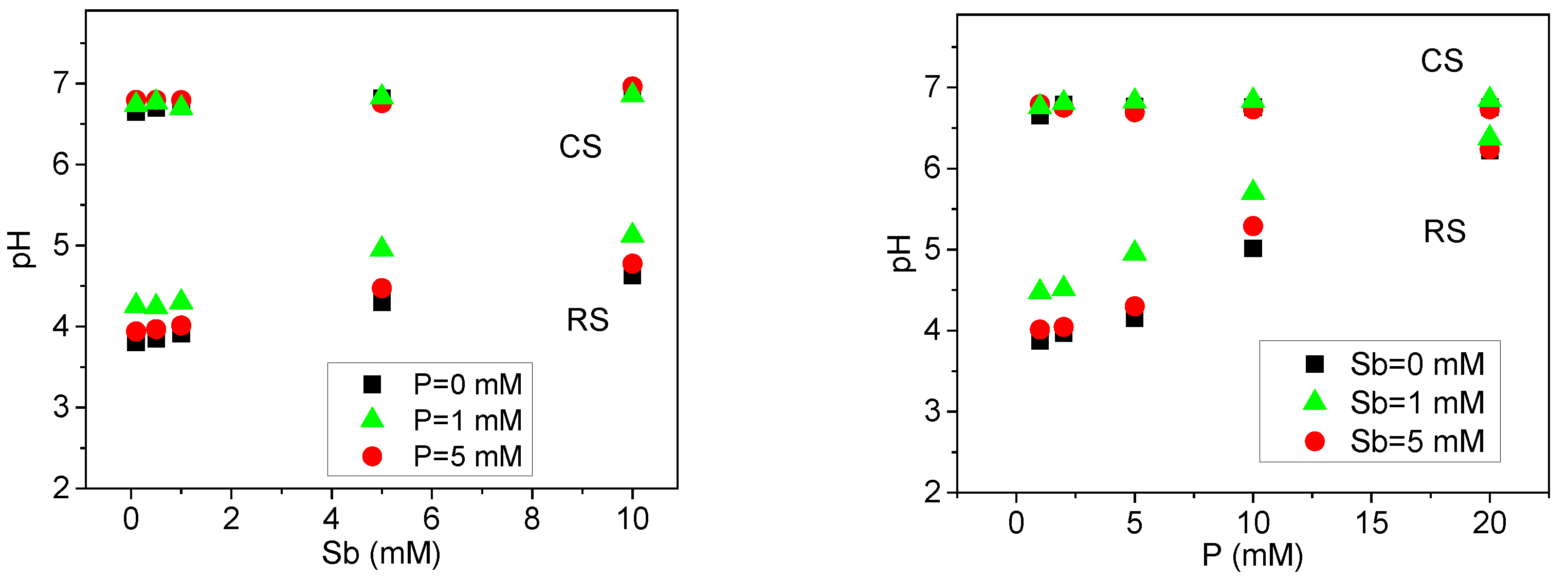
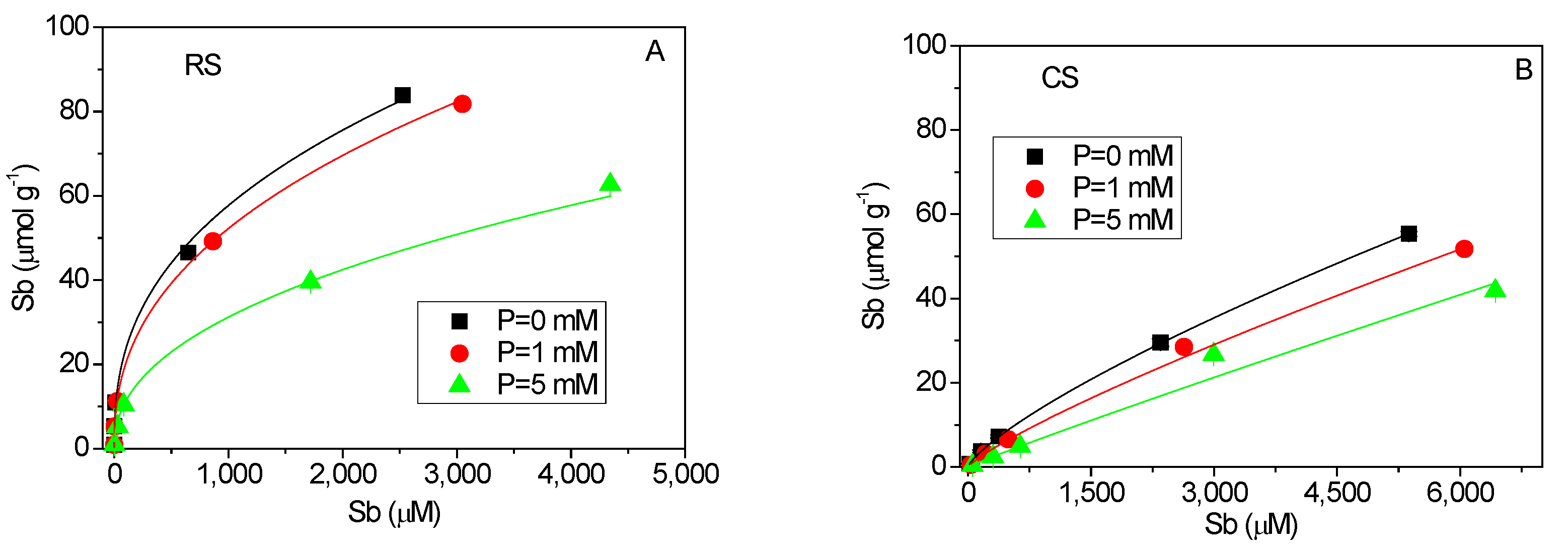
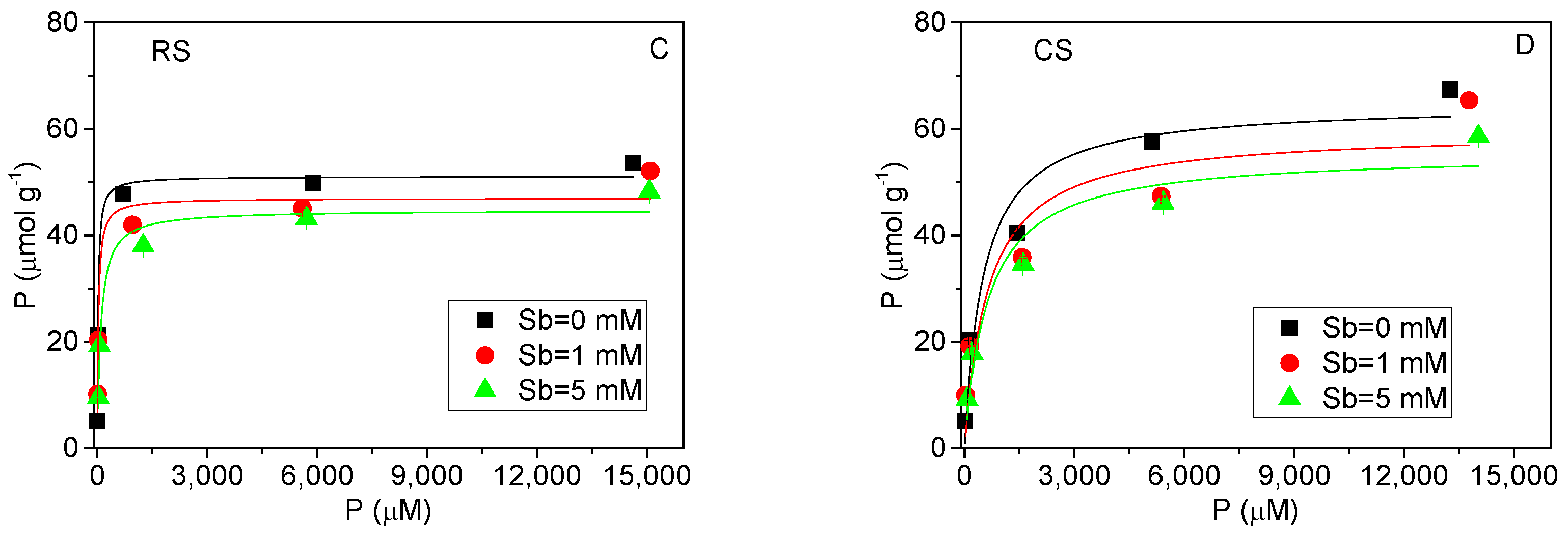
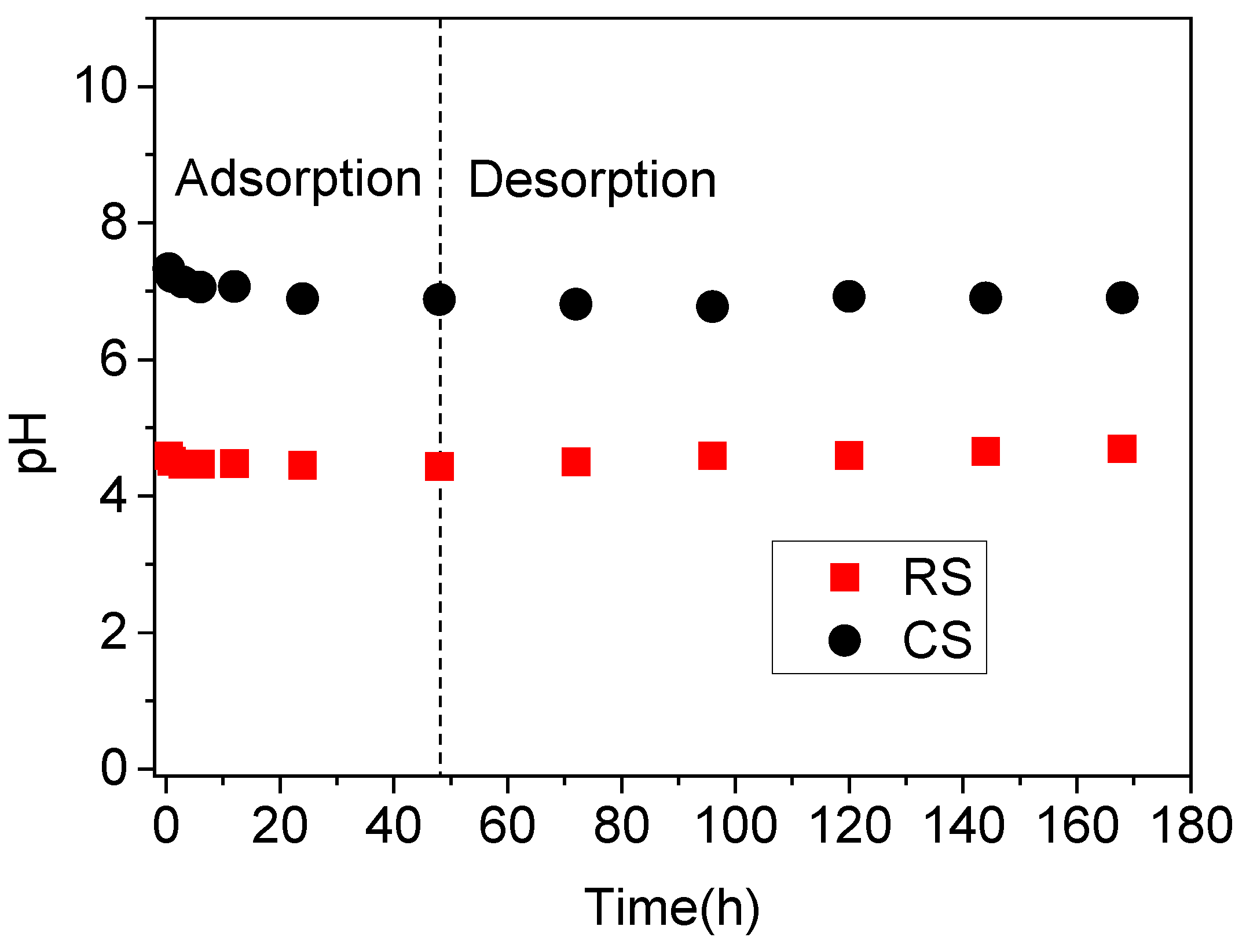

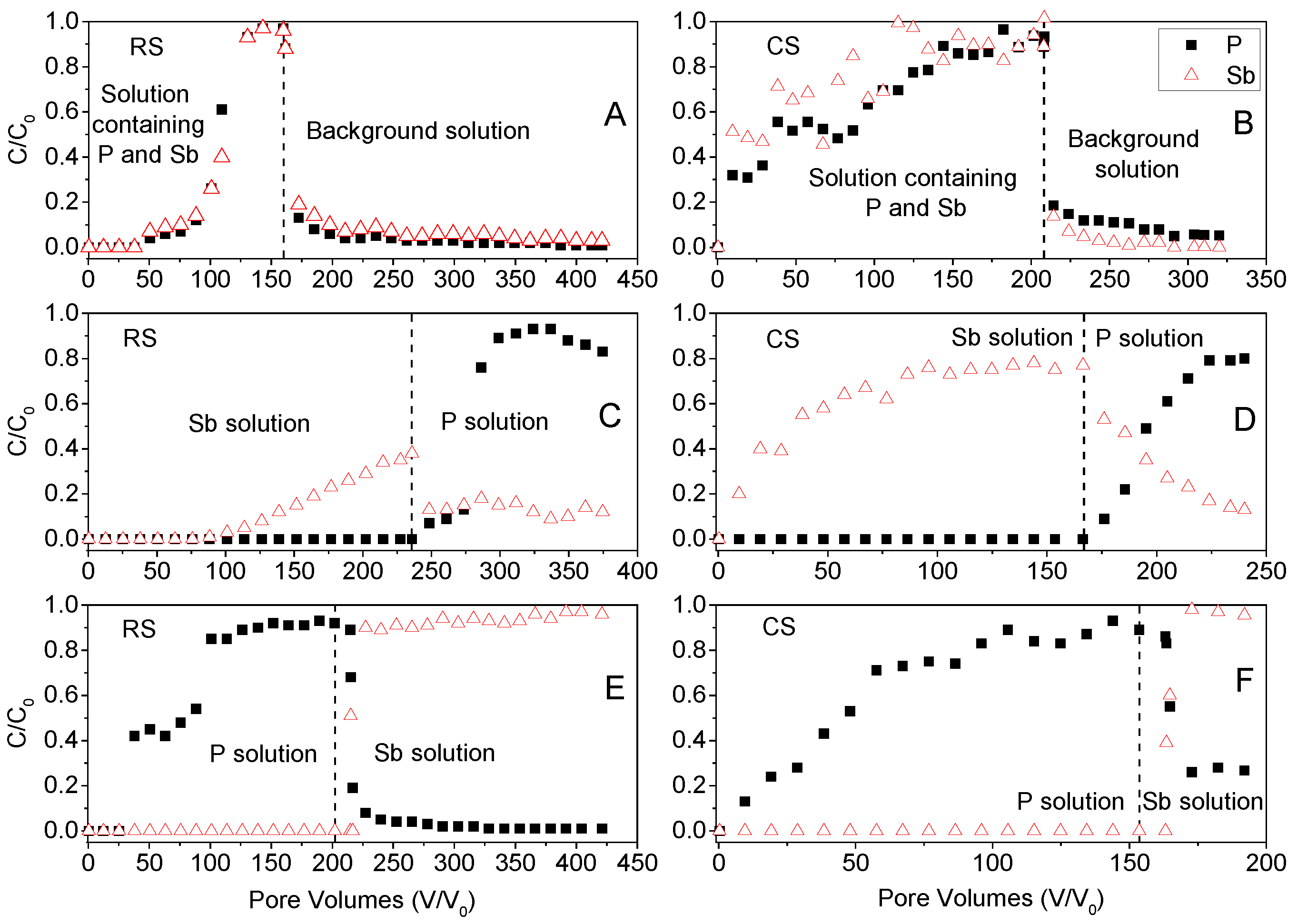
| Soil | pH | TOC 1 (g kg−1) | CEC 2 (cmol kg−1) | Total Fe (g kg−1) | Total Al (g kg−1) | Sand 3 (%) | Silt (%) | Clay (%) |
|---|---|---|---|---|---|---|---|---|
| RS | 4.8 | 2.1 | 16 | 26 | 13 | 31 | 54 | 14 |
| CS | 7.4 | 25 | 25 | 52 | 22 | 33 | 49 | 16 |
| Groups | P(V) (mM) | Sb(V) (mM) |
|---|---|---|
| Single phosphate solution | 1, 2, 5, 10, 20 | 0 |
| Single antimony solution | 0 | 0.1, 0.5, 1, 5, 10 |
| Phosphate and antimony mixed solution | 1, 2, 5, 10, 20 | 0, 1, 5 |
| Phosphate and antimony mixed solution | 0, 1, 5 | 0.1, 0.5, 1, 5, 10 |
| Element | Soil | Treatment | Langmuir | Freundlich | ||||
|---|---|---|---|---|---|---|---|---|
| Qmax (μmol/g) | 1/KL (μmol/L) | R2 | KF (μmol g−1)/[(μmol L−1)1/n]) | N | R2 | |||
| Sb | RS | P = 0 mM | 114.9 | 939.4 | 0.97 | 3.926 | 0.39 | 0.99 |
| P = 1 mM | 55.31 | 101.6 | 0.98 | 3.011 | 0.41 | 1 | ||
| P = 5 mM | 46.95 | 292.6 | 0.98 | 1.455 | 0.44 | 1 | ||
| CS | P = 0 mM | 107.4 | 5176 | 0.99 | 0.076 | 0.77 | 1 | |
| P = 1 mM | 129.8 | 9129 | 1 | 0.038 | 0.83 | 1 | ||
| P = 5 mM | 204.7 | 24,355 | 0.99 | 0.011 | 0.94 | 0.98 | ||
| P | RS | Sb = 0 mM | 51.06 | 22.08 | 0.99 | 13.45 | 0.15 | 0.82 |
| Sb = 1 mM | 46.96 | 29.24 | 0.94 | 12.06 | 0.16 | 0.92 | ||
| Sb = 5 mM | 44.74 | 94.74 | 0.96 | 8.398 | 0.19 | 0.89 | ||
| CS | Sb = 0 mM | 64.73 | 513.9 | 0.91 | 5.69 | 0.26 | 0.98 | |
| Sb = 1 mM | 59.63 | 642.5 | 0.81 | 4.47 | 0.28 | 0.99 | ||
| Sb = 5 mM | 55.44 | 636.9 | 0.92 | 3.75 | 0.29 | 0.98 | ||
Disclaimer/Publisher’s Note: The statements, opinions and data contained in all publications are solely those of the individual author(s) and contributor(s) and not of MDPI and/or the editor(s). MDPI and/or the editor(s) disclaim responsibility for any injury to people or property resulting from any ideas, methods, instructions or products referred to in the content. |
© 2025 by the authors. Licensee MDPI, Basel, Switzerland. This article is an open access article distributed under the terms and conditions of the Creative Commons Attribution (CC BY) license (https://creativecommons.org/licenses/by/4.0/).
Share and Cite
Lu, X.; Zhao, Y.; Yao, K.; Meng, F.; Li, F.; Wu, Z.; Cai, Y. Adsorption–Desorption of Antimony (V) and Phosphorus (V) in Two Typical Soils: Release Behavior and Environmental Implications. Water 2025, 17, 3038. https://doi.org/10.3390/w17213038
Lu X, Zhao Y, Yao K, Meng F, Li F, Wu Z, Cai Y. Adsorption–Desorption of Antimony (V) and Phosphorus (V) in Two Typical Soils: Release Behavior and Environmental Implications. Water. 2025; 17(21):3038. https://doi.org/10.3390/w17213038
Chicago/Turabian StyleLu, Xingyu, Yuting Zhao, Kefeng Yao, Fande Meng, Feiyue Li, Zhenyu Wu, and Yongbing Cai. 2025. "Adsorption–Desorption of Antimony (V) and Phosphorus (V) in Two Typical Soils: Release Behavior and Environmental Implications" Water 17, no. 21: 3038. https://doi.org/10.3390/w17213038
APA StyleLu, X., Zhao, Y., Yao, K., Meng, F., Li, F., Wu, Z., & Cai, Y. (2025). Adsorption–Desorption of Antimony (V) and Phosphorus (V) in Two Typical Soils: Release Behavior and Environmental Implications. Water, 17(21), 3038. https://doi.org/10.3390/w17213038






